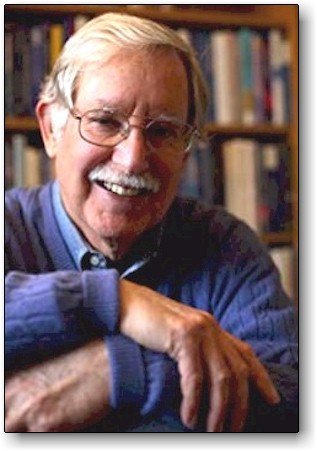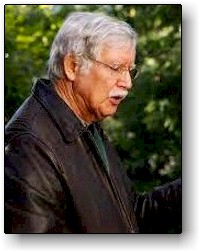|
 Dr.
Kenneth Ring was born in San Francisco on
December 13, 1935. In 1963, he graduated
with his Ph.D. in social psychology from the
University of Minnesota. Dr. Ring took his
first teaching position as an assistant
professor of psychology at the University of
Connecticut, where he remained as a faculty
member until 1994. Though he retired from
teaching at this point, he continued to work
at the university as a Professor emeritus
until December of 1996, at which point he
moved back to the Bay Area of California,
where he has resided ever since. Dr. Ring is the co-founder
and past president of the
International Association for Near-Death Studies
(IANDS) and is the founding editor of the
Journal of Near-Death Studies. Dr.
Kenneth Ring was born in San Francisco on
December 13, 1935. In 1963, he graduated
with his Ph.D. in social psychology from the
University of Minnesota. Dr. Ring took his
first teaching position as an assistant
professor of psychology at the University of
Connecticut, where he remained as a faculty
member until 1994. Though he retired from
teaching at this point, he continued to work
at the university as a Professor emeritus
until December of 1996, at which point he
moved back to the Bay Area of California,
where he has resided ever since. Dr. Ring is the co-founder
and past president of the
International Association for Near-Death Studies
(IANDS) and is the founding editor of the
Journal of Near-Death Studies.
In 1977, Dr. Ring,
as a young professor of psychology, read Raymond
Moody's book, Life
After Life, and was inspired by it. However,
he felt that a more scientifically structured
study would strengthen Moody's findings. So
he sought out 102 near-death survivors for his
research. Ken's ground-breaking book,
Life At Death: A Scientific Investigation of
the Near-Death Experience, was published
by William Morrow and Company in 1980. In 1984,
the company published Ken's second book,
Heading Toward Omega: In Search of the Meaning
of the Near-Death Experience. Both books
deal with near-death experiences and how they
change people's lives. His research also involves
the ground-breaking work of investigating near-death
experiences among blind persons. His findings
are detailed in his book
Mindsight: Near-Death and Out-of-Body Experiences
in the Blind (1999) which has become a classic
in the annals of near-death research much like
his previous books,
The Omega Project: Near-Death Experiences, UFO
Encounters, and Mind at Large (1992), and
his most well-known and celebrated NDE book,
Lessons from the Light: What We Can Learn from
the NDE (2000).
Ken has researched
NDEs that involve the experiencer witnessing
events while out of their body which is later
proven to have taken place. Ken has also researched
NDEs that affirms reincarnation which have been
published in scholarly journals. Ken has also
examined NDEs among those who attempted suicide.
During his extensive research, Ken was also
able to examine NDEs where the future was foretold.
Ken's latest book,
Waiting to Die: A Near-Death Researcher's (Mostly
Humorous) Reflections on His Own Endgame
(2019), is composed of fifteen sparkling and
delightfully witty essays which answers his
personal thoughts on, "What is it like
waiting to die?"
Ken is also the co-author
of
Methods of Madness: The Mental Hospital as a
Last Resort (1969). He is also is a co-author
of
Letters from Palestine: Palestinians Speak Out
about Their Lives, Their Country, and the Power
of Nonviolence (2011). In November 2008,
Dr. Ring visited Israel as part of a peace delegation
and subsequently protested the
Israeli air strikes on the Gaza Strip as completely
disproportionate.
During the COVID
pandemic, Ken published his latest book
Reflections in a Glass Eye: Essays in the
Time of COVID (2021). Now in his
mid-80s, this book shows he has lost none of
his verve for writing on a range of subjects
as diverse as they are entertaining. But
quite apart from his gift for the droll
phrase, the reader will find that Ring also
touches on and often goes into depth on
serious topics, such as dealing with the
COVID pandemic, the right-to-die movement,
and the epidemic of loneliness.
The following information
is Ken Ring's research conclusions from his
ground-breaking Connecticut study.
 (1)
Those cases who came
closest to death, or were clinically dead, just
as Moody's cases reported, told of being outside
of their bodies, of moving through a void or
dark tunnel toward a luminous light, of meeting
with departed relatives and friends, of having
a feeling of great comfort and bliss and of
being surrounded by compassionate love, a feeling
so beautiful they longed to remain, and when
they returned to the "earthly" realm,
they were affected by this feeling the rest
of their lives. (1)
Those cases who came
closest to death, or were clinically dead, just
as Moody's cases reported, told of being outside
of their bodies, of moving through a void or
dark tunnel toward a luminous light, of meeting
with departed relatives and friends, of having
a feeling of great comfort and bliss and of
being surrounded by compassionate love, a feeling
so beautiful they longed to remain, and when
they returned to the "earthly" realm,
they were affected by this feeling the rest
of their lives.
(2)
No one type of person
was especially likely to have this experience.
It cut across race, gender, age, education,
marital status, and social class.
(3)
Religious orientation
was not a factor affecting either the likelihood
or the depth of the NDE. An atheist was as likely
to have one as was a devoutly religious person.
(4)
Regardless of their
prior attitudes - whether skeptical or
deeply religious - and regardless
of the many variations in religious beliefs
and degrees of skepticism from tolerant disbelief
to outspoken atheism - most of these people
were convinced that they had been in the presence
of some supreme and loving power and had a glimpse
of a life yet to come.
(5)
Drugs, anesthesia
and medication did not seem to be a factor in
inducing these impressions and exquisite feelings
of an NDE. Indeed, drugs and anesthesia seemed
to be more likely to cause a person to forget
memories of an NDE.
(6)
He definitely concluded
that NDEs are not hallucinations because hallucinations
are rambling, unconnected, often unintelligible
and vary widely, whereas NDEs tend to have similar
elements of a clear, connected pattern.
(7)
Based on the information
of those who had reported such incidents, the
moment of death was often one of unparalleled
beauty, peace and comfort - a feeling of
total love and total acceptance. This was possible
even for those involved in horrible accidents
in which they suffered very serious injuries.
Dr. Ring found there was a tremendous comfort
potential in this information for people who
were facing death.
(8)
After going through
an NDE, people reported a loss of fear of death
as well as a greater appreciation of life. They
also reported stronger feelings of self-acceptance
and a greater concern and sense of caring for
other people. They had less interest in
material things for their own sake. Many tended
to become more spiritual - though not necessarily
more involved in organized religion.
(9)
Almost all subjects who experienced an NDE found
their lives transformed and a change in their
attitudes and values, and in their inclination
to love and to help others. Dr. Ring was convinced
that these were absolutely authentic experiences
and noted that since returning, many of them
had occasion to think about ‘what
might have been.' And their subsequent lives
were powerful testimony to our common ability
to live more deeply, more appreciatively, more
lovingly, and more spiritually.
|